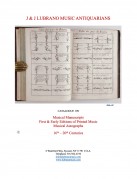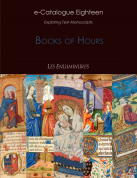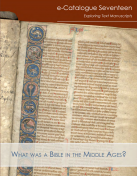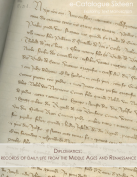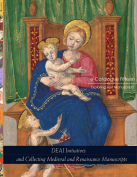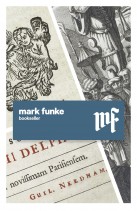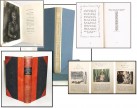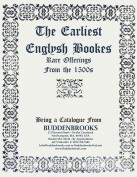A Leaning Tower of Paperbacks (and a few pulps) A different sort of list from us featuring vintage mass market paperbacks which run the gamut from sleaze to thriller, science fiction to good girl art. We chose these from a single collection simply for their covers, occasionally content, or just for being in unusually great shape. We think the books speak for themselves, so we've added very little in terms of description. Please enjoy.
Bookseller Catalogs
A Leaning Tower of Paperbacks (and a few pulps) A different sort of list from us featuring vintage mass market paperbacks which run the gamut from sleaze to thriller, science fiction to good girl art. We chose these from a single collection simply for their covers, occasionally content, or just for being in unusually great shape. We think the books speak for themselves, so we've added very little in terms of description. Please enjoy.
From the Library of Blanche DeVries and Pierre Bernard Tremendous collection of Hindu and Buddhist texts from the library of American yoga pioneers, Blanche DeVries and Pierre Bernard. These books were acquired by a single owner from Samuel Weiser's shop at its second Broadway location, Weiser likely having acquired them around the time of DeVries' death in the 1980s. We suspect most or all of them were rebound at that point in India by the owner. The group includes manuscripts from DeVries, books inscribed to her, and material from the Tantrik Order in America, Living Arts Center, and Clarkstown Country Club. Though many do not contain ownership marks, we can be almost certain they are all from the couple's library due to the content and chain of ownership.
Pierre Bernard (1875-1955) known as "The Great Oom", "The Omnipotent Oom" and "Oom the Magnificent" is widely credited as the first American to introduce the philosophy and practices of yoga and tantra to the American people. Bernard founded his Tantrik Order in America in 1905 or 6, a secret society with lodges at least in San Francisco and Seattle (New Orleans is also listed as a "Supply Depot" on the front cover of its single published journal issue), and later New York. The activities of the order were sensationalized by press partly due to a sexual scandal involving a female student in 1910. The Tantrik Order taught yoga and Hindu philosophy as a blueprint for living, but Bernard is credited with the exaggerated association of tantra with mystical sex in American opinion because of his lodge rituals, sensationalized and not, involving sex initiation, opium, occult practices, blood oaths, and other "iniquities." Around 1919, Bernard opened the Clarkstown Country Club in Nyack, New York where he, DeVries and other prominent guest lecturers would teach yoga and other new age practices to affluent clientele. The 72 acre compound became the birthplace of modern American yoga.
Blanche DeVries (1891-1984) moved to New York from Adrian, Michigan at an early age and met Bernard in 1913, becoming a student at one of his Yoga schools. After just a year, she was appointed head of his yoga school for women, and the two married in 1918. She then opened her own Gymnosophy institute, teaching yoga and sensual dance in a five-floor town house. This institute along with Bernard's Clarkstown Country Club in Nyack helped refine modern yoga practice, popularizing the exercise system and Hindu philosophy, especially among women, in America. Around 1938, DeVries opened the Living Arts Center, the first woman-owned yoga studio in the country. Through her teaching there, she helped contribute to a shift in attitude about women's autonomy and sexuality.
The books, pamphlets, journals, and manuscripts in this collection all relate closely to the teachings of the two yogis. They represent key influences on DeVries and Bernard's shaping of modern yoga practice and spreading of Hindu and Buddhist belief systems both in physical culture and esoteric thought in America.
E-Catalogue Eighteen: Books of Hours Omnipresent in the late Middle Ages and Renaissance, Books of Hours are often called the bestseller of the Middle Ages. Today they are one of the most common types of manuscript surviving from this era, found widely in public and private collections, and often reproduced.
E-Catalogue Seventeen: What Was a Bible in the Middle Ages? If you consult Webster’s dictionary, you will learn that “The Bible” is the texts that are considered sacred by Jews and Christians, and also the physical object that includes these texts. This e-catalogue explores selective aspects of the Bible in the Middle Ages, seen through the lens of 14 manuscripts.
E-Catalogue Sixteen: Records of Daily Life from the Middle Ages and Renaissance
By Les Enluminures, Ltd.E-Catalogue Sixteen: Records of Daily Life from the Middle Ages and Renaissance Legal and administrative records from public and private sources, or documents, might sound a little dry, or a little specialized. If that was your first thought, the items collected here in this short list will surprise you both with their immediacy (they all record things of real importance to everyone mentioned in their text) and, often, with their beauty, seen in their script, handsome notary marks, and even, at times, illumination.
E-Catalogue Fifteen: DEAI Initiatives and Collecting Medieval and Renaissance Manuscripts
By Les Enluminures, Ltd.E-Catalogue Fifteen: DEAI Initiatives and Collecting Medieval and Renaissance Manuscripts DEAI initiatives (Diversity, Equity, Access, and Inclusion) ask us to think differently about building collections, particularly collections in academic institutions. At Les Enluminures we recognize that the process can at first seem especially challenging for manuscripts from the Middle Ages and Renaissance. But if you dig a little deeper, nothing is further from the truth.
Selections of Harrison of Paris - Monroe Wheeler Press Monroe Wheeler, co-founder of the Monroe Wheeler Press, established in 1930 in New York and part of the Paris literary scene of ex-pats during the 1920s. They transformed fine press publishing by blending literary works with sophisticated design aligned with the modernist movement.
Collaborating with Harrison M. Weisman, known as ‘Harrison of Paris,’ they produced limited-edition books that became artistic expressions. The press, renowned for rare typefaces and high-quality papers, left a legacy in the world of fine printing in their quest to elevate the book as an art form.
The Earliest English Books Rare Offerings From The 1500s
How to request a print version: Some of the Earliest Books Printed in England
